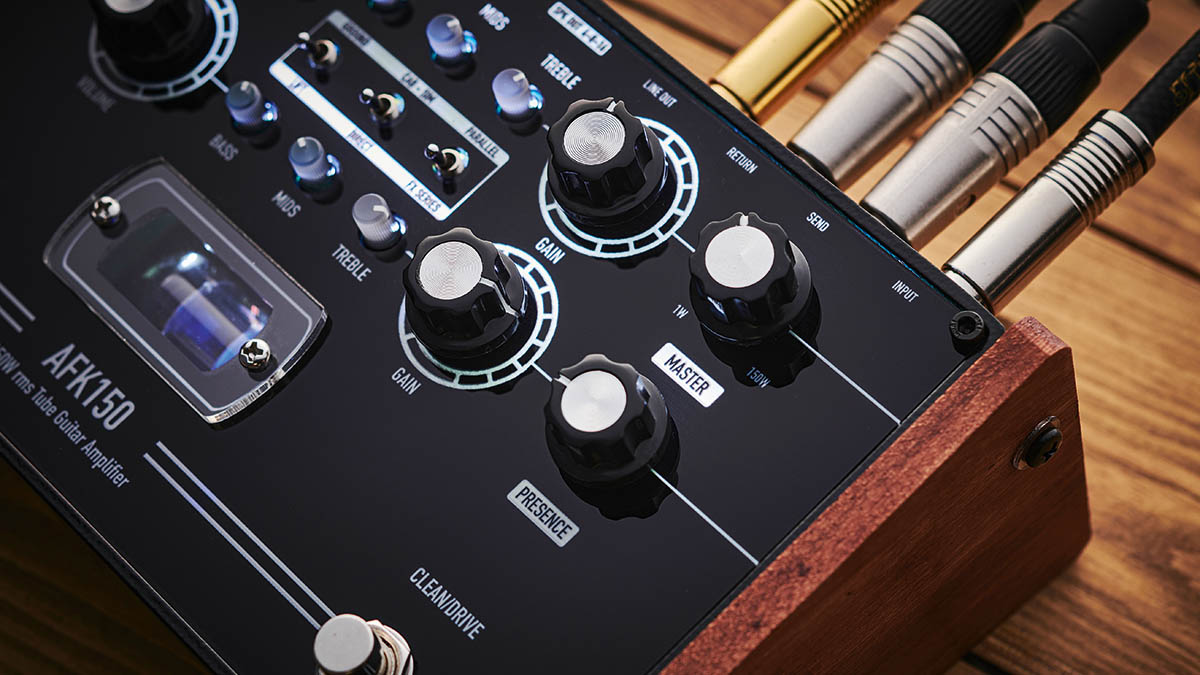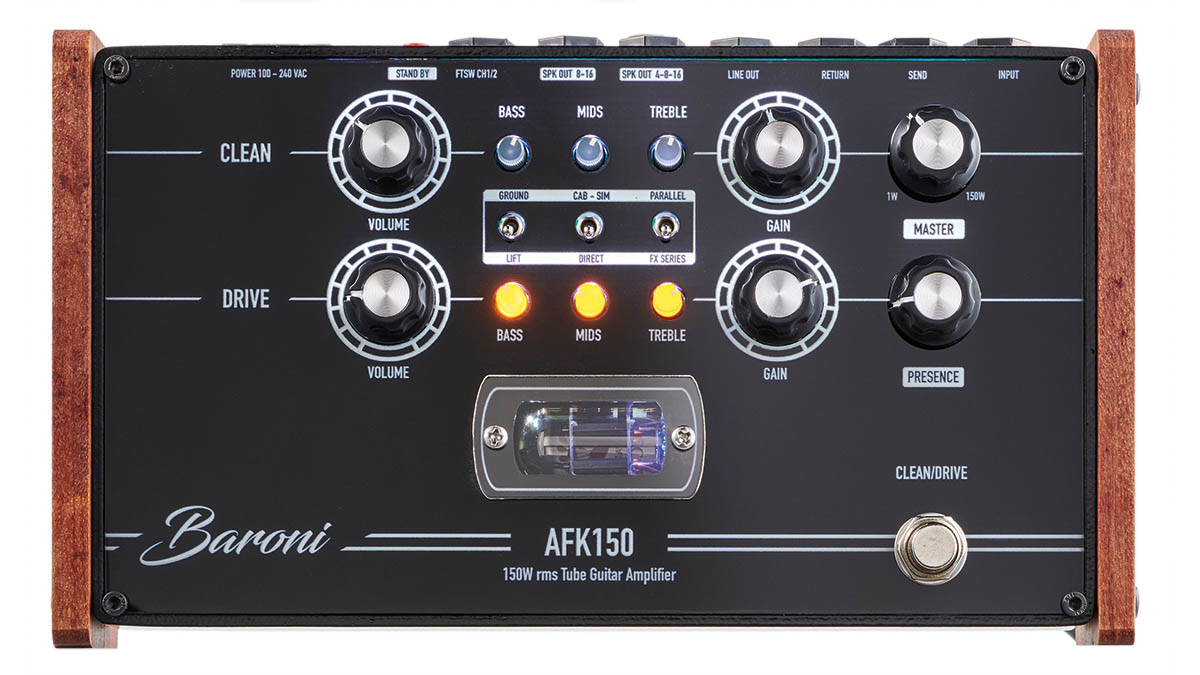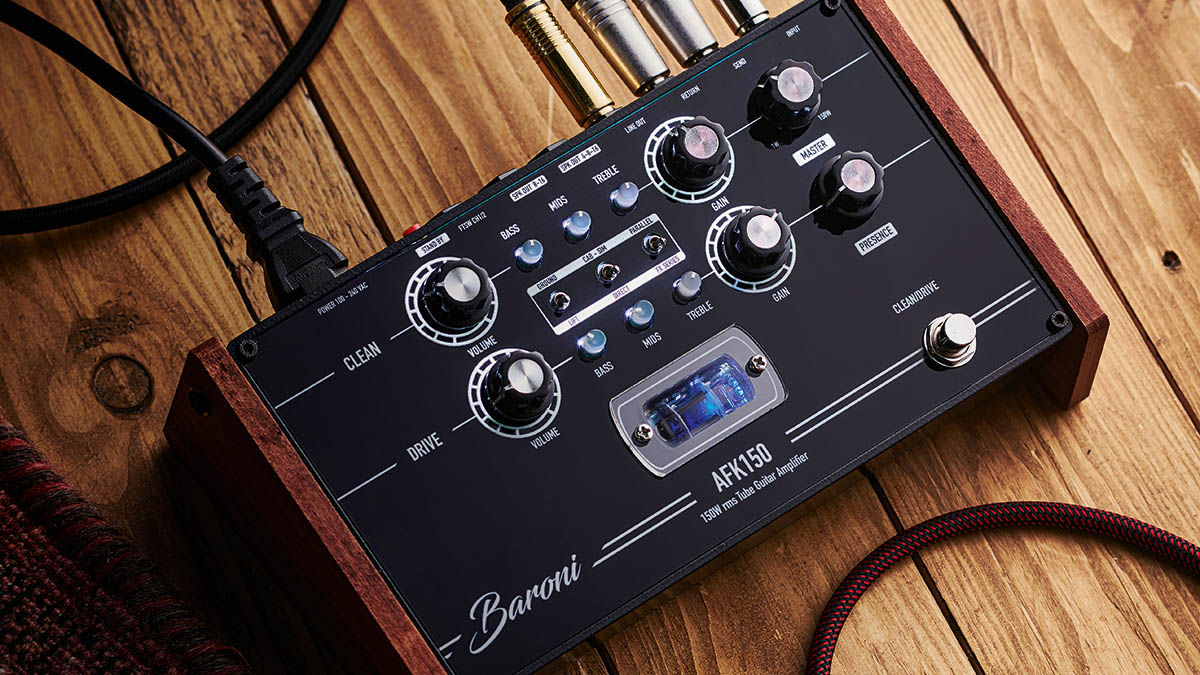Guitar World Verdict
Compared to the competition, we think the AFK150 is really good value for money. Aimed at serious amateurs and pro players, it’s a great choice if you’re looking to build a super-portable rig for local gigs or touring.
Pros
- +
Compact, very portable.
- +
Warm USA-inspired clean channel.
- +
Brit-inspired vintage overdrive channel.
- +
Low noise levels for recording
- +
Plenty of power for live.
Cons
- -
No mains on/off switch or externally replaceable fuse (we’d recommend using a switchable power strip).
- -
Second footswitch to bypass effects loop would have been welcome.
You can trust Guitar World
Italy’s contribution to the guitar universe is bigger than many people realise, with many famous brands including Eko, Binson and Meazzi, from Sicily, playing pivotal roles in the development of some of the biggest names in rock and pop.
Today, Italy’s guitar amp and pedal scene continues to flourish. Here, we’re looking at the new AFK150 compact pedalboard head from Ugo Baroni, a well-known amp and pedal designer from northern Italy, currently producing a range of Chinese-manufactured pedals under the Foxgear Distribution umbrella brand, which also includes Gurus – another well-known Italian amp and pedal builder.
The Baroni AFK150 is a hybrid design with a 12AX7-based preamp feeding a Class D output stage that’s capable of delivering a respectable 150 watts RMS into a four-ohm load.
Power comes from a universal switched mode supply that will accept anything between 100 and 240 volts AC, so you can plug the AFK150 into the wall anywhere in the world.

Slightly unusually for a mains-powered device, there’s no on/off power switch or external fuse access. The electronics fit into a sturdy cast alloy tray with the control panel forming the lid, secured by four Allen screws.
The backlit acrylic control-panel graphics pay a subtle tribute to Binson’s classic Echorec spinning disk delays, made in Milan and famously used by Pink Floyd in the late ’60s and early ’70s, most visibly in the Live At Pompeii film.
As well as making things much easier to see in low-light conditions, it’s a cool feature with plenty of vintage mojo. On our sample the backlighting was a little uneven – somewhat dimmer on the lower half of the panel and on some of the connection labels along the top edge.
All the latest guitar news, interviews, lessons, reviews, deals and more, direct to your inbox!

The 12AX7 valve that powers the AFK150’s preamp is horizontally mounted and visible through a Perspex window, while the rest of the electronics are miniature components on densely packed PCBs.
There are two ventilation slots in the front and rear sides, with all the connections at the back. Pressing the red standby switch on the rear panel puts the AFK150 in play mode, activating coloured LEDs on the tone controls, which light up to show you which channel is active: blue for the clean channel and orange for the drive channel, while the 12AX7 valve gets its own blue LED to complement the red glow of the heater filaments.

It’s a proper two-channel design and has separate gain, volume and EQ controls for its clean and drive channels. There’s also a global master volume and presence knob to quickly tweak the amp for live use.
The bass, mid and treble controls are traditional passive networks, with different frequency centres for a Fender-ish clean and a Marshall-ish drive.
There are three small toggle switches between the two sets of EQ controls. The first is a ground lift for the unbalanced line output, while the second selects the AFK150’s integrated cabinet simulation or bypasses it, if you prefer to use a separate solution. The third toggle switches the amp’s effects loop between series and parallel operation, with parallel being the preferred choice for delays and modulation effects.

Besides the loop send and return sockets, other rear-panel connections include a single input jack, the fixed-level unbalanced line out, and a remote footswitch socket, which toggles the AFK150’s channels if you prefer to use the head on top of a speaker cabinet. Additionally, for pedalboard use, there’s a single footswitch on the control panel’s bottom right, safely distanced from other knobs and switches.
There are two speaker output jacks wired in parallel for a minimum load of four ohms, as well as the standby switch, which mutes the speakers but leaves power connected to the valve to reduce warm-up time. Like many pedal amps on the market right now, the AFK150 can be used without speakers, meaning that you can connect the line out to a console or DAW for silent recording or quiet stage environments.
Overall, the AFK150 is a good-looking pedal, with very compact dimensions that should fit easily on most ’boards, tipping the scales at just under 1kg (2lb).

Feel & Sounds
We tried out Baroni’s AFK150 with our regular guitars: a Stratocaster fitted with Duncan Alnico Pro single coils and an old Les Paul loaded with PAFs. To check out the effects loop, we also used a Zoom MultiStomp that was running chorus and delay models.
Whatever equipment you use, especially when gigging, it’s good practice to always use proper mains protection. We use an APC surge protector in the wall mains supply, which has its own power switch, so the Baroni’s lack of one wasn’t an issue for us.
The AFK150’s USA-inspired clean channel is very sweet, with plenty of headroom and an impressively smooth EQ that’s equally flattering to humbuckers and single coils. There’s just enough gain to push this channel into a gentle overdrive that sounds great for blues and country, while adding a touch of chorus from the parallel loop makes a great rhythm tone. There’s no loop mix control, so you have to turn off the dry signal in the effect and vary the effect volume to taste.
There’s an impressive reserve of gain on tap with the lead channel, more than enough to make the weediest of single coils sing and sustain. However, unlike some high-gain preamps, the lower-gain settings are just as rewarding to use, convincingly emulating vintage Brit stack sounds of the late ’60s and early ’70s.
Meanwhile, swapping to humbuckers and turning up the gain puts you into fully-saturated ‘Tweed on steroids’ MTV-era ZZ Top territory. There’s plenty of volume to get your point over – 150 watts RMS into four ohms means the AFK150 is properly loud when needed.
Even when producing roughly 75 watts into an eight-ohm cab, it’s still more than enough to handle most pub gigs, with a clarity and definition most older solid-state output stages can’t match.
Verdict
Traditions are often hard to shake off. Many of us are used to guitar amplifiers being large heavy boxes, frequently transported in even larger and heavier boxes to protect their fragile valve-powered circuits – and it’s been like that since the dawn of rock ’n’ roll. However, thanks to recent improvements in Class D amplification, switched-mode power supplies and sub-miniature electronics, it doesn’t have to be that way any more.

The package may be light, but the AFK150’s valve-based preamp delivers heavyweight tone that easily covers a wide range of playing styles, from jazz to classic and modern rock, with smooth interactive EQs to suit any guitar.
We’d like to have seen a second footswitch button to bypass the effects loop, especially as Baroni has gone to the trouble of providing a parallel option, but at this price that’s really all we can grumble about.
Specs
- PRICE: £549
- ORIGIN: China
- TYPE: Valve/solid-state preamp, solid-state power amp.
- OUTPUT: 150W RMS into 4 ohms, 75W RMS into 8 ohms
- VALVES: 1x 12AX7
- DIMENSIONS: 220 (w) x 125 (d) x 50mm (h)
- WEIGHT (kg/lb): 0.9/2
- CABINET: Cast alloy
- CHANNELS: 2
- CONTROLS: Clean Channel: volume, gain, bass, mid, treble. Drive channel: volume, gain, bass, mid, treble. FX loop series/parallel switch, cab sim in/out switch, ground lift switch, channel footswitch. Global master volume, presence
- FOOTSWITCH: Standard latching footswitch (not supplied) toggles channels
- ADDITIONAL FEATURES: Series/parallel effects loop, unbalanced line out with switchable cab simulation option and ground lift
- OPTIONS: None
- RANGE OPTIONS: None
- CONTACT: Foxgear
Nick Guppy was Guitarist magazine's amp guru for over 20 years. He built his first valve amplifier at the age of 12 and bought, sold and restored many more, with a particular interest in Vox, Selmer, Orange and tweed-era Fenders, alongside Riveras and Mark Series Boogies. When wielding a guitar instead of soldering iron, he enjoyed a diverse musical career playing all over the UK, including occasional stints with theatre groups, orchestras and big bands as well as power trios and tributes. He passed away suddenly in April 2024, leaving a legacy of amplifier wisdom behind him.


